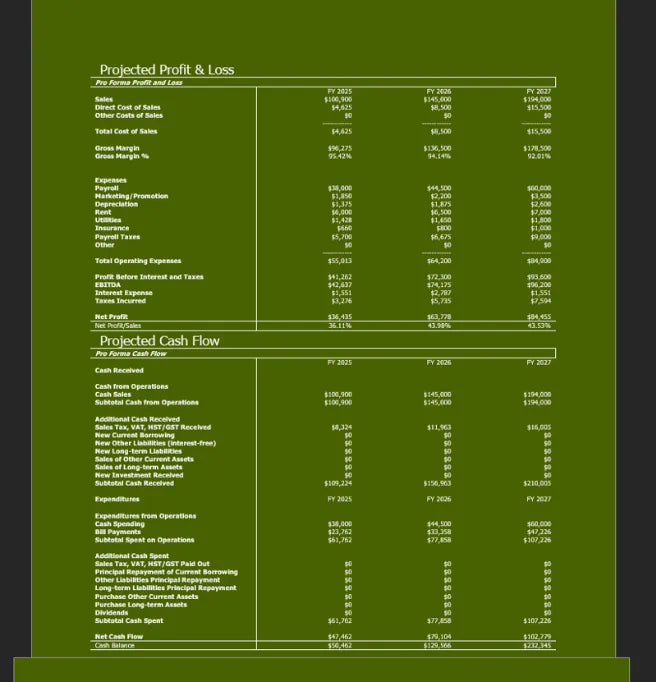
Mobile & Seasonal Business Plan Hub (U.S., 2025)
A single hub that ties together hot dog carts, shaved ice, cotton candy, hunting & fishing sh...
Read More →





Launching an indoor go kart racing venue isn’t just about speed — it’s about convincing U.S. lenders, landlords, and partners that your karts, track layout, parties, and memberships will actually pay the rent. This template gives you that lender-style story in plain English.
Delivered instantly in editable Word and PDF, it follows the SBA-aligned order reviewers are used to seeing: executive summary, market, operations & safety, management, marketing, and a defendable 36-month forecast tied to real capacity math (races per hour × karts available × pricing × membership/party upsells).
It’s written for U.S. operators converting a warehouse, joining a family entertainment center (FEC), or adding a high-margin racing experience to an existing venue — so you can present a serious, bank-ready case without paying consultant rates.
BPlanMaker specializes in U.S. business plans for experience-based venues — karting, laser tag, indoor playground, arcades. Templates are reviewed quarterly against current SBA expectations, family entertainment benchmarks, and U.S. labor/insurance guidance so you are not handing an outdated plan to a banker.
Quick answer: A U.S.-focused indoor go kart business plan explains the concept, local family/corporate demand, track and safety operations, staffing, marketing, and a 36-month forecast tied to rides/hour and party/membership sales — so lenders can see how you’ll cover rent, payroll, and insurance.
This template mirrors what U.S. SBA reviewers, banks, and landlords usually ask for: executive summary first, then market, then operations/safety, then management and financials. It is informed by current U.S. entertainment/attractions reporting, BLS amusement & recreation indicators (2024–2025), and live BPlanMaker customer feedback from FEC/camp/venue launches.
Update cadence is quarterly so your plan can reference recent employment, insurance, and family-entertainment notes without you rewriting the whole document.
Indoor kart venues touch several U.S. requirements: occupancy/load approvals, fire/sprinkler and e-kart charging safety, general liability and workers’ compensation, and in some cities, amusement/attraction permitting. The plan gives you space to note your city/county approvals, written safety briefings, and insurance coverages so a reviewer sees you’ve thought through risk.
Add your state-specific items (entity, sales tax, local inspections) in the compliance section without breaking the flow of the plan.
You get a structure that looks the way banks expect, but written for regular operators — not for consultants. It’s fast to localize (your city, your space, your program mix), and the 3-year model is already pointed at the levers that actually move revenue in karting.
Key risks & mitigations:
Most U.S. indoor kart operators use a tiered menu: single heats for drop-ins, 3-race bundles for groups, memberships for locals, and party/corporate packages with guaranteed minimums. Your forecast should assume prime-time pricing on weekends and slightly lower weekday rates to keep staff utilized.
The template leaves room for track-rental/buyout pricing, helmet/suit rentals, and concessions so you can show multiple revenue lines to lenders.
Start from track capacity and safety spacing, then model around races/hour. Many indoor venues model 8–12 karts per race, but add 1–2 spares for maintenance and battery swaps. The plan’s 3-year schedule lets you phase additional karts in once memberships and events grow.
For most U.S. markets, yes — that’s where basket size jumps. The template explains how to present party rooms, timed race blocks, and upgrades (extra laps, trophies, cake/food, photo/video) so non-karting buyers still understand the value.

U.S. family entertainment and location-based attractions have stayed resilient heading into 2025, helped by strong weekend/holiday traffic and group events. Indoor karting sits in the same decision set as laser tag, indoor playgrounds, and arcades — venues that can package birthdays and corporate team-building. Recent attraction reports and BLS amusement/recreation data show steady spend and employment levels across 2024–2025, which supports lender-friendly growth assumptions for new FEC-style concepts.
Sources: IAAPA/attractions commentary for North America (2025); U.S. Bureau of Labor Statistics — Amusement, Gambling & Recreation Industries, employment & earnings (2024–2025); lender feedback on family-entertainment startups.
What You’ll Turn In: Polished, SBA-style business plan in Word and PDF, 3-year financial forecast, startup cost list, and a simple launch/marketing outline for the first 90 days.
What You’ll Customize: City/county details, square footage and track layout notes, pricing tiers, staff counts and wages, insurance language, local partnerships, and membership/party names.
What’s Not Included: Legal or tax advice, local inspection fees, or custom spreadsheets beyond the 3-year model.
Every week you wait, other venues lock in prime birthday slots, group events, and memberships. This template gets you lender-style documentation in hours.
Download, edit, and present a data-driven indoor go kart plan that U.S. reviewers recognize.
Buy Now & Download Instantly – Start Your Kart TrackLast updated: November 2025 by BPlanMaker.
Templates are educational business documents, not legal or tax advice.
BPlanMaker


Couldn't load pickup availability





Explore our latest articles on writing a stronger business plan, using your business plan template, and getting ready for lenders, investors, and SBA programs.

A single hub that ties together hot dog carts, shaved ice, cotton candy, hunting & fishing sh...
Read More →
U.S. 2025 guide to planning a shaved ice / snow cone business with the SBA-style layout lenders e...
Read More →
U.S. 2025 guide to planning a hunting & fishing shop with the SBA-style layout lenders expect...
Read More →